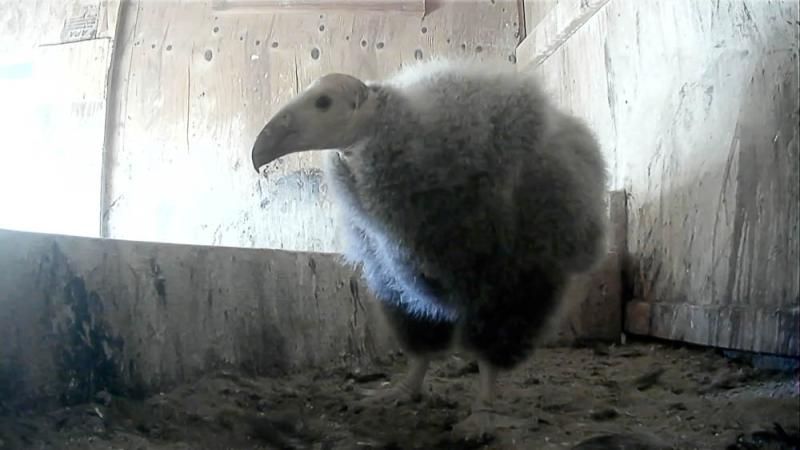Egg-ceptional year for condors at conservation center

Seventh chick hatches overnight, offering more hope for critically endangered species
With seven fuzzy chicks now squawking in their nests, it's been an egg-cellent season for California condor recovery at the Oregon Zoo's Jonsson Center for Wildlife Conservation.
The center's final chick of the season hatched late in the evening on May 14, and is being raised by experienced condor mom Malibu. Malibu is such an attentive parent that she's barely left the nest box since the chick hatched, according to keepers. Care staff have only caught glimpses of the new arrival, but are keeping a close eye on the nest-cam monitors.
"We had more mating pairs than ever this year, which is great news for the future of the condor recovery program," said Kelli Walker, the zoo's lead condor keeper. "All seven chicks appear to be healthy and thriving, which should mark a significant step forward in the recovery of this critically endangered species."
The chicks will stay with their parents for at least eight months before moving to the Jonsson Center's pre-release pens for about another year. Eventually, they will travel to a wild release site to join free-flying condors in California, Arizona or Baja Mexico.
With scarcely more than 500 birds left in the world, each new condor is vitally important to the species' survival, according to Walker.
"If you think about it," she said, "the seven chicks being raised here right now make up more than 1 percent of all the California condors on the planet."
The Oregon Zoo's condor recovery efforts take place at the Jonsson Center for Wildlife Conservation, located in rural Clackamas County on Metro-owned open land. The remoteness of the facility minimizes the exposure of young condors to people, increasing the chances for these birds to survive and reproduce in the wild. California condor breeding programs are also operated at San Diego Zoo's Wild Animal Park, the Los Angeles Zoo and the Peregrine Fund's World Center for Birds of Prey in Idaho.
The California condor was one of the original animals included on the 1973 Endangered Species Act and is classified as critically endangered. In 1982, only 22 individuals remained in the wild and by 1987, the last condors were brought into human care in an attempt to save the species from extinction. Thanks to recovery programs like the Oregon Zoo's, the world's California condor population now totals more than 500 birds, most of which are flying free.
Condors are the largest land birds in North America with wingspans of up to 10 feet and an average weight of 18 to 25 pounds. They are highly intelligent and inquisitive, and they require a tremendous amount of parental investment in the wild.
Accumulated lead poisoning — a problem that plagues all raptors and scavengers — is the most severe obstacle to the California condor's recovery as a species. As the birds feed on carrion and other animal carcasses, they can unintentionally ingest lead from bullet fragments. Lead consumption causes paralysis of the digestive tract and results in a slow death by starvation. Lead also causes severe neurological problems, so the birds not only starve but also suffer from impaired motor functions.
Through its Non-Lead Hunting Education Program, the Oregon Zoo aims to inspire hunters — traditionally some of the strongest supporters of wildlife and habitat conservation — to continue that legacy by choosing non-lead ammunition.
More News

Zoo seeks pika watchers for summer season
The Oregon Zoo is recruiting volunteers for Cascades Pika Watch.April 15, 2025

Zoo convenes action for imperiled elephants
Sabah government representatives joined conservation NGOs, local communities, palm oil producers, and tourism operators this week in the fight to save the world’s smallest elephants from extinction.April 11, 2025

Double fluff: Zoo welcomes first condor chicks of season
The first two California condor chicks of 2025 hatched at the Oregon Zoo’s Jonsson Center for Wildlife Conservation.April 3, 2025

